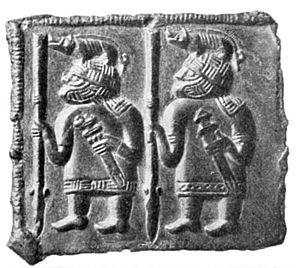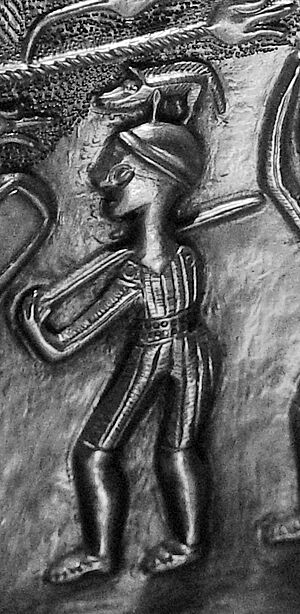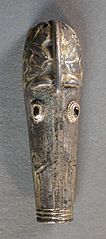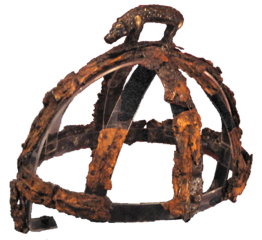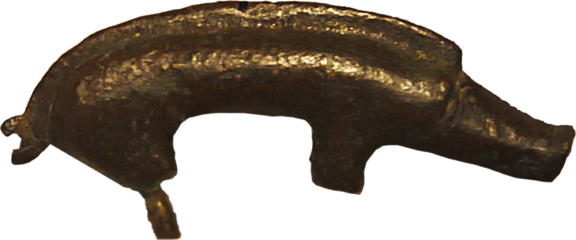Germanic boar helmet facts for kids
Germanic boar helmets were special helmets used by people in England and Sweden long ago, during the Vendel period and Anglo-Saxon times. These helmets had decorations like a boar on top or pictures of boars. People believed these boar symbols would protect the wearer in battle. Some also think these helmets were part of a ritual, helping warriors become like a boar, similar to berserkers. They might also be linked to the god Freyr.
Contents
Boars in Ancient Times
Boars in Europe Before the Germanic Peoples
The boar was a very important animal symbol across Europe for thousands of years. People respected, hunted, and ate boars. Symbols of boars appeared on items from different cultures, like the La Tène culture (around 4th century BC) and Gaulish people. The Romans also used the boar as a symbol.
The boar was considered sacred to a mother goddess by some Celtic groups. The Roman historian Tacitus wrote that the Baltic people called Aesti wore boar symbols to ask for protection from this goddess in battle. Even four Roman armies, including one in Britain, used the boar as their symbol.
One of the clearest examples of a boar-crested helmet outside Germanic areas is on the Gundestrup cauldron. This ancient pot, from around 200 BC to 300 AD, is usually thought to be Celtic.
Boars and Germanic Peoples
Boars were very important to the Germanic peoples and were strongly connected to fighting. A special battle formation called the "boar's snout" was used by Germanic warriors. It was shaped like a wedge and was first mentioned in the 4th century AD. This formation was still used in the medieval period, as described in old stories like Knýtlinga saga.
In old myths, a boar named Saehrimnir is killed every day to feed the einherjar, who are brave warriors in Valhalla. The gods Freyr and Freyja also owned special boars: Gullinbursti (golden bristles) and Hildisvíni (battle-swine). Both Freyr and Freyja have names linked to pigs. For example, boars were sometimes called Vaningi, which is another name for Freyr. Freyja was also called Sýr, meaning "sow" (a female pig).
Sometimes, pigs were sacrificed and eaten in special ceremonies called blóts. Boars were also central to promises or vows called heitstrenging, where the boar was seen as holy. Many scholars believe these ceremonies were dedicated to Freyr. Old stories also show a clear link between Freyr and these vows. Small gold figures of pigs, called Guldgubbar, have been found, and their use is linked to worshipping gods like Freyr and Freyja.
Boar symbols and religious practices were very important in Sweden, which was a main place for worshipping Freyr. Some think the boar was a special animal for certain groups there. Both the Swedish Yngling royal family and some Icelandic families who came from Sweden were said to worship Freyr and own boars.
Many Germanic names include a part that means "wild boar," like Jǫfurfǫst and Jǫfurbjǫrn, found in old Swedish writings. The word jǫfurr originally meant "boar" but later came to mean "ruler" or "prince." This change might be because boar helmets were often worn by nobles.
Even though boars are often linked to Freyr and Freyja, it's important to remember that the boar also had its own meaning and wasn't always connected to these gods.
Boar Helmets Found by Archaeologists
Helmets and Fragments Discovered
Archaeologists have found parts of boar-crested helmets and helmet fragments in England. These date back to the Anglo-Saxon period. One famous example is the Benty Grange helmet, found in Derbyshire, from the 7th century AD.
Boars also appear on the eyebrow parts of the Sutton Hoo Helmet. This helmet has features similar to both Anglo-Saxon and Vendel era helmets. Some think it might have been made in Sweden. It's thought that the idea of boar helmets came to Britain from the European mainland after the Roman period, rather than continuing from Roman times.
The boar on the Benty Grange helmet might have had real boar bristles, making its crest stand out. This would have shown the animal's aggression and fierceness, fitting for battle. Some also suggest the golden decoration on the boar represents Freyr's boar Gullinbursti, who had golden bristles. However, there's no direct proof that this story was known in England at that time.
Boar Images on Plates
No full boar-crested helmets have been found in Scandinavia yet. However, plates showing warriors wearing them have been discovered in Sweden from the Vendel era. The Vendel I helmet, from around 650 AD, has plates showing a rider with a bird of prey and a boar-crested helmet.
Similarly, the Valsgärde 7 helmet has a plate showing two warriors with spears and boar-crested helmets. This image looks a lot like one of the 6th-century Torslunda plates. Some experts believe the helmets shown on these plates are an older style than the helmets they decorate.
Boars in Old Stories
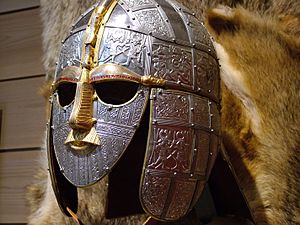
Old English Stories
Beowulf
Boar helmets are mentioned five times in the famous Anglo-Saxon poem Beowulf. In some parts, the boars seem to stand freely on top of the helmets, like the Guilden Morden example. This is mentioned when Grendel's mother attacks:
|
Com þa to Heorote, ðær Hring-Dene |
She came to Heorot. There, inside the hall, |
| —Old English text | —Heaney Translation |
In another part, Hrothgar is sad about his advisor's death:
|
Ne frín þú æfter saélum, sorh is geníwod |
Do not ask about happy times! Sorrow has come again upon the |
| —Old English text | —Tolkien Translation |
In two other mentions, boars are spoken of in the plural. For example, when Beowulf and his men leave their ship, "Boar-shapes flashed above their cheek-guards" (Old English: eoforlic scionon ofer hleorbergan). These might refer to boars like those on the eyebrows of the Sutton Hoo helmet, rather than crests on top.
Elene
In the poem Elene, the word eoforcumbol appears twice. It has been translated as "boar-crest on a helmet" or "boar-banner." In this story, it is shown as a symbol of protection. It is also presented as a non-Christian symbol, contrasted with the Christian cross.
Old Norse Stories
In Old Norse writings, helmets are sometimes linked to boars, especially those belonging to the Yngling royal family in Sweden. The Swedish king Aðils owned helmets named Hildisvín ('Battle-swine') and Hildigǫltr ('Battle-boar'). Hildisvín was passed down from his uncle, Áli.
Hildigǫltr is also listed as a special poetic word (a heiti) for a helmet in Nafnaþulur. It appears in the poem Háttatal:
|
Holt felr hildigelti |
The excellent warrior covers the hill of the brain's dwelling (his head) with a battle boar (helmet) |
| —Old Norse text | —Faulkes translation |
Another helmet heiti, valgǫltr, is used in Hrafnsmál as part of a battle description:
|
Feldi folks valdi |
First the Folk-wielder |
| —Old Norse text | —Morris translation |
It has also been suggested that the helmet heiti valhrímnir and hallhrímnir refer to pigs. This is because of the part -hrimnir, which is a poetic word for swine. This word is also found in the name Sæhrímnir.
What the Boar Imagery Meant
Boar images on Anglo-Saxon helmets were clearly linked to protection in Beowulf. The poet says the figures on helmets watched over the warriors who wore them. Some believe these figures had a magical role to ward off evil. It's even suggested that if the boar was cut off, the warrior would die. In this idea, the boar and the warrior seemed to be seen as one, sharing a life.
It's also been suggested that wearing a boar-helmet was like shape-changing. Similar to úlfheðnar (wolf-skinned warriors) and berserkers (bear-skinned warriors), the wearer might take on the animal's qualities, not just its look. A helmet plate from Vendel grave XIV in Sweden shows two warriors with bird-crest helmets. One of them also has boar tusks, suggesting the armor made them look like the animal.
In medieval Germanic stories, people could be called boars, like Ragnar Lodbrok in his saga. In the Kjalnesinga saga, a warrior is described as having boar-like teeth when fighting. While wolf- and bear-like warriors were often seen negatively, being compared to a wild boar was positive. It was closely linked to noble warriors. This difference might be because bears and wolves hunt, while boars, though fierce, mostly forage.
See also


